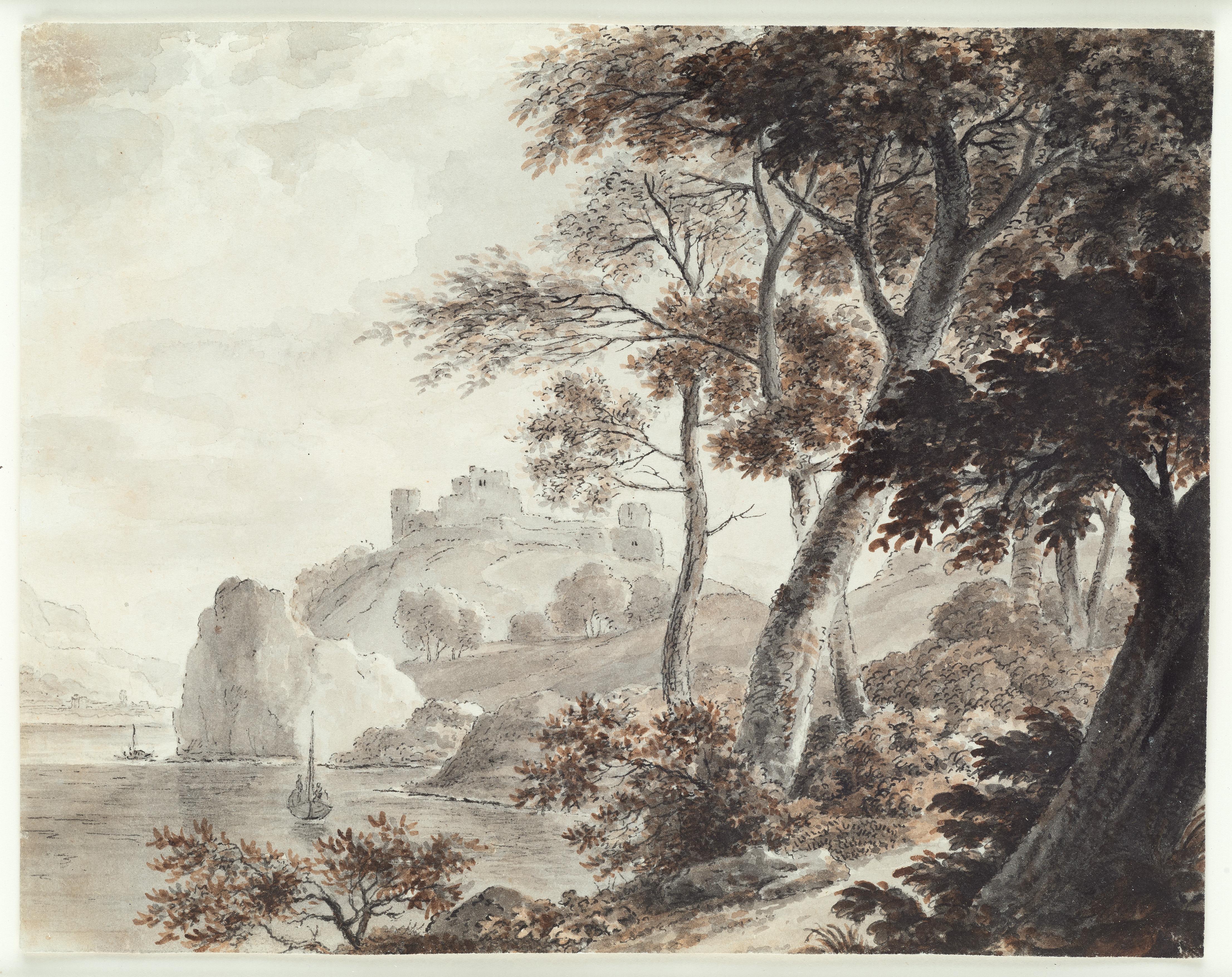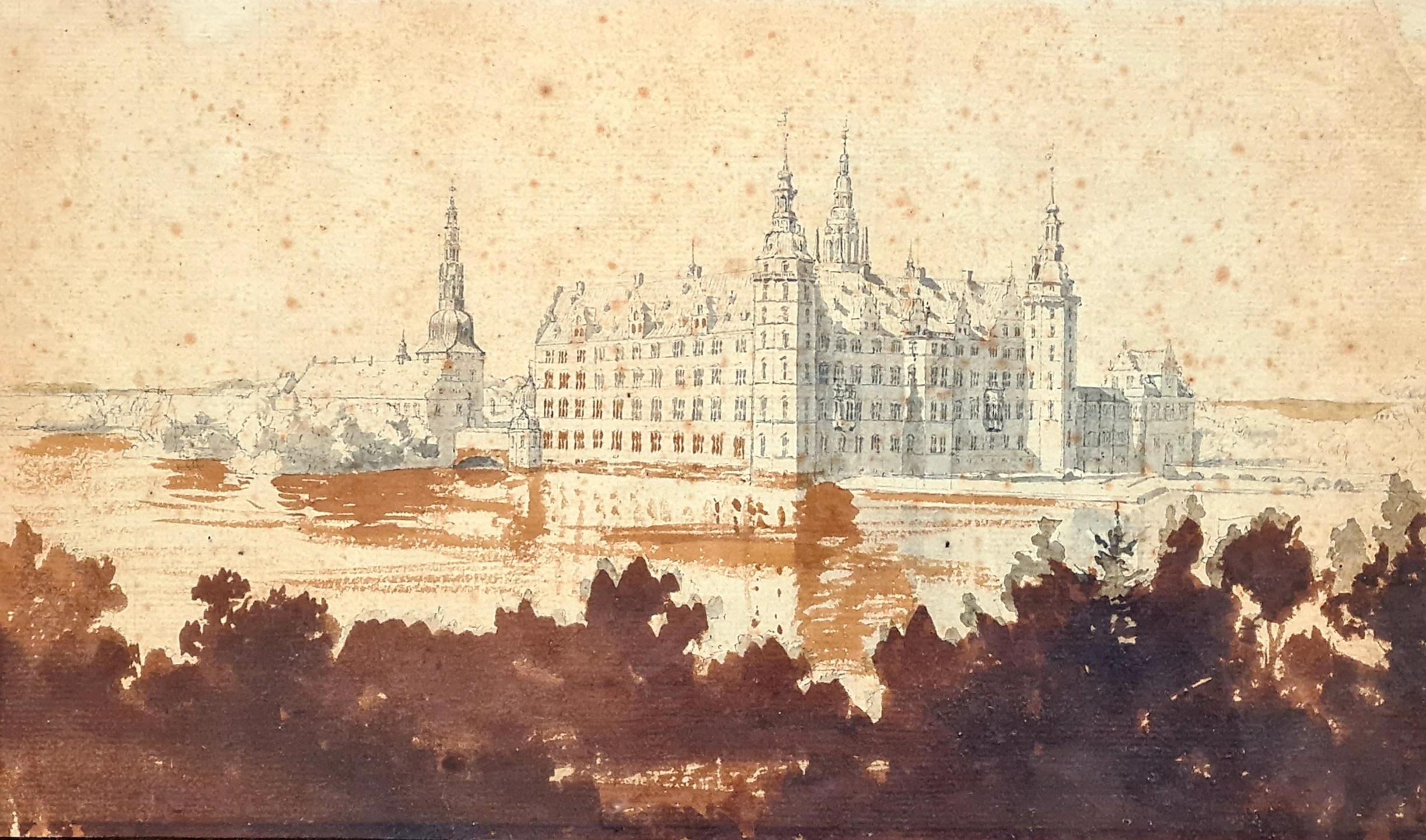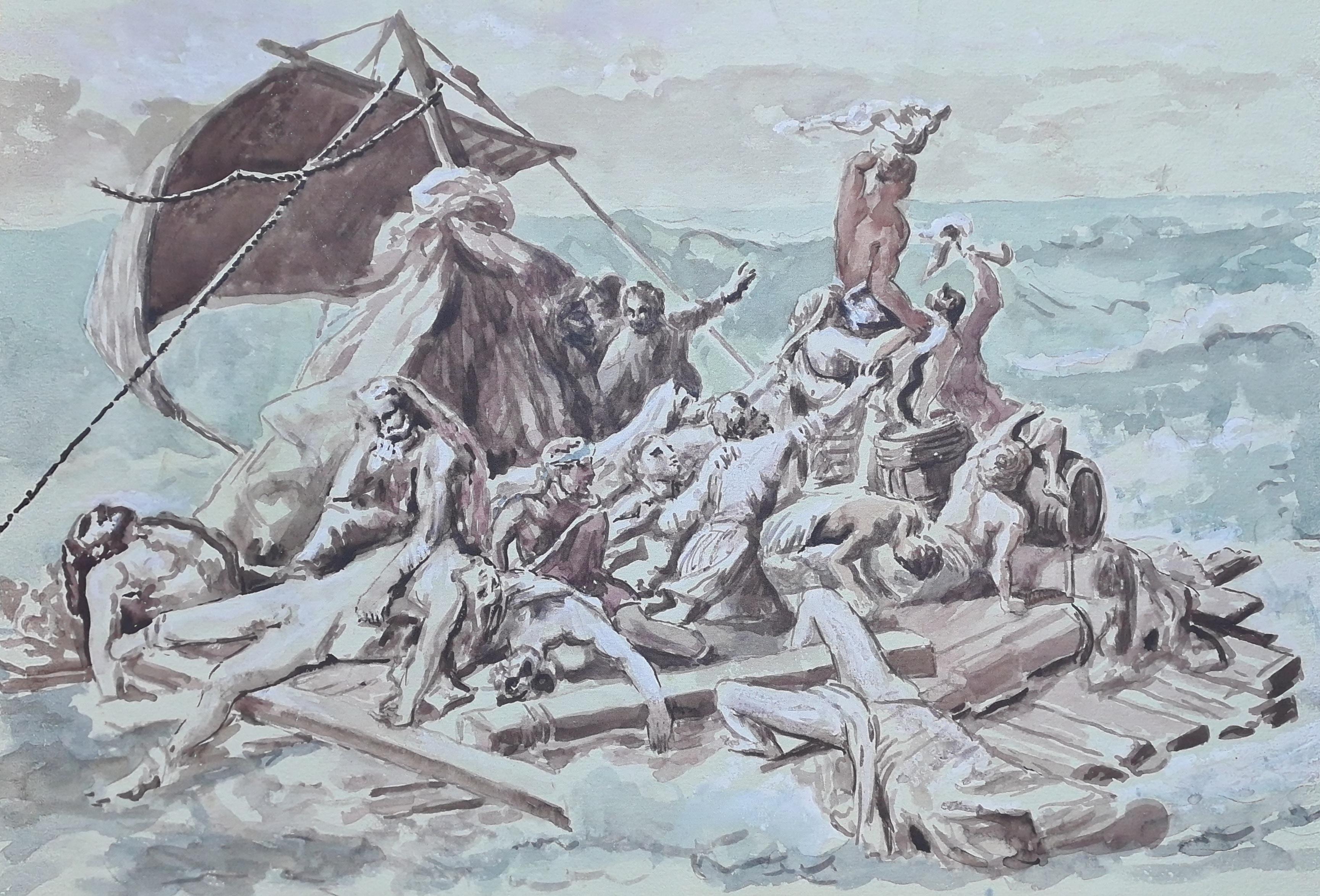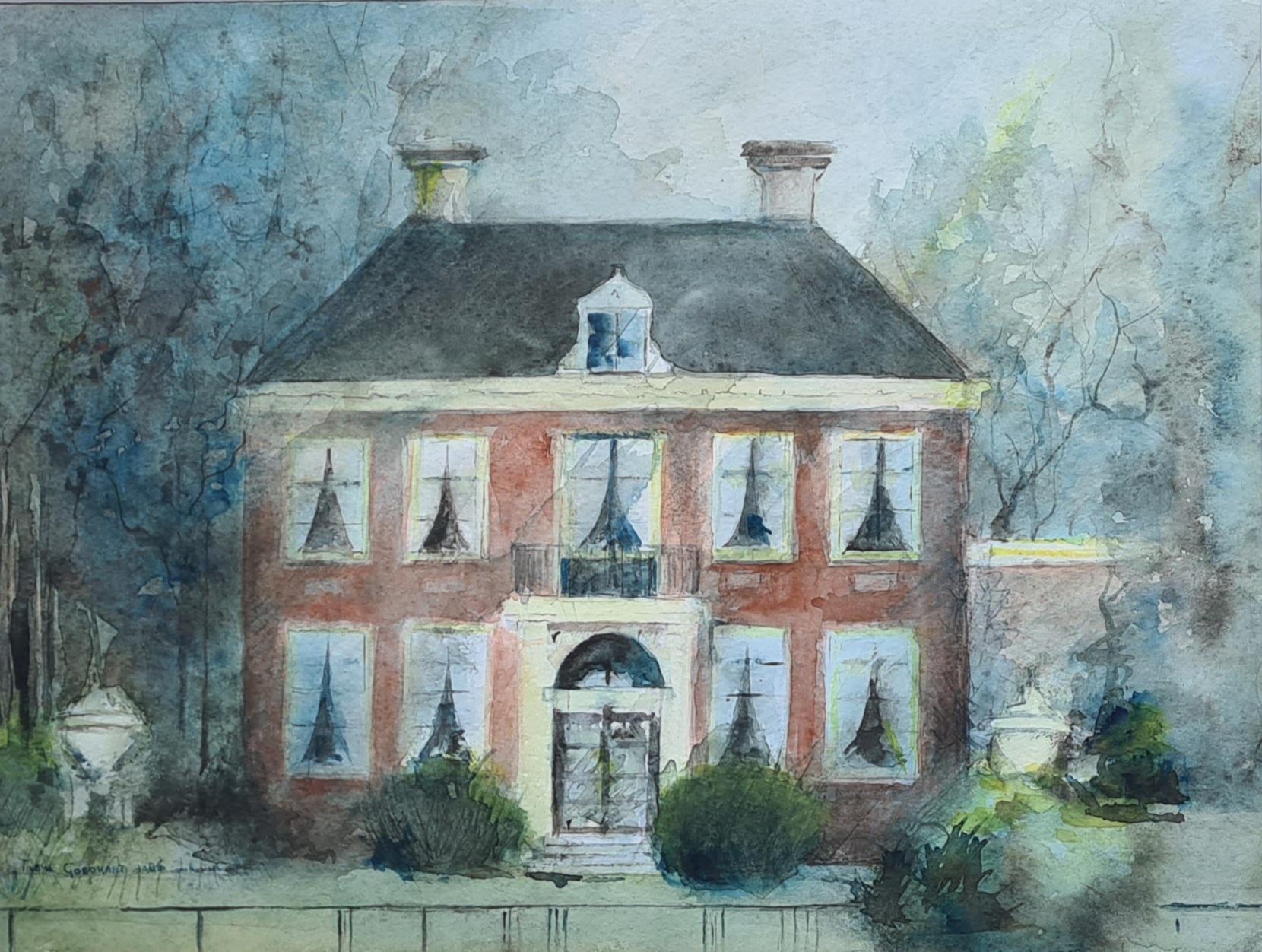Items Similar to La Port De Cannes, 1930. Vieux Port, French Riviera. Côte d'Azur. Paul Delvaux.
Want more images or videos?
Request additional images or videos from the seller
1 of 24
Paul DelvauxLa Port De Cannes, 1930. Vieux Port, French Riviera. Côte d'Azur. Paul Delvaux.1930
1930
About the Item
Paul Delvaux.
Belgian ( b.1897 - d.1994 ).
La Belle Anna, La Port De Cannes, 1930
Watercolor, Bodycolor & Pastel on Woven Paper.
Signed & dated 1930 lower left.
Image size 15.7 inches x 25.8 inches ( 40cm x 65.5cm ).
Frame size 23.8 inches x 33.3 inches ( 60.5cm x 84.5cm ).
Available for sale; this original painting is by the Belgian artist Paul Delvaux and is dated 1930.
The painting is presented and supplied in a sympathetic contemporary frame (which is shown in these photographs), mounted using conservation materials and behind non-reflective Tru Vue UltraVue® UV70 glass.
This vintage watercolor is in very good condition, commensurate with its age. The paper surface has been cleaned on our instruction, supervision and approval. The painting is ready to hang and display.
On the reverse of the woven paper is a pencil drawing of a street scene featuring several human figures and buildings by Paul Delvaux.
The painting is signed and dated 1930 lower left.
Provenance: Christie's, London, 29 March 1988, lot 398. Sale title - Impressionist and Modern Watercolours and Drawings and Contemporary Art.
The Belgian artist Paul Delvaux was one of the most important creators of 20th century imaginary surrealism, with his work combining both modernist and classical features. He has been called a painter of poems and dreams. His style developed over the years, with figurative work dominating his output. His best-known works often featured women, classical architecture, trains, railway stations and skeletons and explores themes of life, death and beauty. Many of his shadowy, dream-like paintings convey a profound sense of curiosity and unease, in the tradition of ‘poetic shock’.
Paul François Ernest Delvaux was born on 23 September 1897 in Anheit, a small village in the province of Liège, in Belgium. He grew up in Brussels in comfortable surroundings; his father was Jean Delvaux, a prominent barrister at the Court of Appeal in Brussels and his mother, Laure Jamotte, was a musician. He was sent to the Athénée de Saint-Gilles in Brussels, one of Belgium’s most prestigious academies, where he received thorough instruction in the humanities. He studied Greek and Latin and absorbed the fiction of Jules Verne and the poetry of Homer’s Odyssey. Some of his childhood experiences made an impression in his future development, particularly in the field of classical studies. He developed an interest in Greco-Roman culture which is evident in his later art.
Upon graduation his parents secured him an office job with a shipping company in Brussels, but it was soon evident that young Paul had no skills or interest in business or law. He was then grudgingly allowed to study architecture at the Académie des Beaux-Arts in Brussels. Here he studied the basics of architecture and perspective drawing but was disqualified due to his weakness in mathematics and was obliged to leave after his first year. He was concerned about his future career and spent his time copying postcards. His mother advised him to paint from nature and in 1919 he produced his first watercolors.
On a family holiday in Zeebrugge in 1919 the painter Franz Courtens met Delvaux and was much impressed by his paintings. He told Delvaux’s parents that their son had real talent and a great future in front of him. Courtens encouraged the failed student to return to the Académie but this time to study painting, and the parents finally acquiesced to this plan. From this point Delvaux was able to indulge in his real passion for art and determined this was to be his career. He returned studied at the Académie with the decorative painter Constant Montald and others. He was also greatly encouraged by Alfred Bastien and Jean Delville. During 1920-21 Delvaux performed mandatory military service whilst also studying.
Between 1920 and 1925 Delvaux completed around 80 paintings, mostly naturalistic landscapes in a plein-air impressionist vein. In 1924 he set up a studio in his parents’ house in Brussels and in 1925 held his first solo exhibition.
During the next decade Delvaux’s paintings began to feature nudes in landscapes, strongly influenced by Flemish Expressionists. Few paintings from his era survived; Delvaux recorded the destruction of 50 of his canvasses to re-use the frames.
By the mid-1920s his idea of painting changed, so that he was no longer satisfied by a reproduction of what he saw. He began to invoke the lyricism of antiquity, particularly in his figurative work.
In 1929 Delvaux met and fell in love with Anne-Marie de Maertelaere, whom he called ‘Tam’. They were very happy for a short while, before his domineering mother forced him to end the relationship and made him promise never to see her again. (It is interesting that the warm, joyous painting we offer here, depicting a boat called ‘La Belle Anna’ comes from this short period of happiness in Delvaux’s personal life.) After the couple separated his paintings took on a more isolated, detached tone. His mother died in 1932.
From around 1930 Delvaux turned briefly to expressionism as a way of dealing with some of the contradictions in the world he saw around him. By the mid 1930s he was working within the sensibility of Surrealism. In 1934 he joined Salvador Dalí, de Chiraco and Magritte in an exhibition entitled Minotaure at the Palais des Beaux-Arts de Bruxelles. In 1936 he and Magritte had separate shows at the Palais, which received favorable reviews.
In 1937 Delvaux’s father died and he married Suzanne Purnal, although he later said that this was purely a marriage of convenience. Between 1937 and 1941 Delvaux perfected his mature artistic style, reflecting the increasing anxiety of the times. His work was included in the 1938 Exposition Internationale du Surréalisme in Paris and a solo exhibition in London the same year was also successful. When Germany invaded and occupied Belgium in 1940 he returned to Brussels and spent the war years quietly continuing to paint, but not exhibiting in Belgium.
In 1945 Delvaux had a major retrospective show at the Palais des Beaux-Arts. In the post-war years Delvaux continued the productive period he had started under the German occupation, and produced many works that would later establish his reputation. As Delvaux’s career had developed in the shadow of Nazi Germany, it is perhaps not surprising that his post-war work is known for its sense of anxiety and unease, although not expressed in overtly political subjects.
It has been said that the works of 1945-47 are rendered in a flattened style with distorted and forced perspective, reflecting the fact that he was at the time trapped in a loveless marriage.
In 1947 the influential Julien Levy Gallery in New York mounted a show of his paintings, which was well received by critics, although two of his paintings were seized by Customs as obscene.
In 1947 Delvaux met Tam again in a chance encounter at a newsstand in Saint-Idesbald and they resumed their close relationship. Delvaux divorced his first wife and moved to a new temporary home with Tam. In 1951 they built a small house/studio in the coastal dunes of Saint-Idesbald and married the following year. They remained inseparable until Tam’s death in 1989.
Delvaux was recognized with many honors and appointments in his later life. From 1950 to 1962 he served as Professor of ‘monumental painting’ at the École Nationale Supérieure d’Arts et d’Architecture de La Cambre, Brussels. In 1958 he became a Member of the Royal Academy of Science, Letters and Fine Arts of Belgium. In 1963 he became vice-director of the Académie Royal de Belgique and then in 1965 became its president.
Beginning in the 1950s, Delvaux executed a number of mural commissions; in 1952 he collaborated with Emile Salkin and three students from La Cambre to produce a wall mural at the gaming room in the Ostend Kursaal, portraying a Roman-style classical dancing scene. Two years later he collaborated with Salkin again for a series of wall panels at the house of Gilbert Périer in Brussels. In 1959 he collaborated with Ysette Gabriels and Charles Van Deun to paint Le Paradis Terrestre, a huge mural at the Palais des Congrès in Brussels. He worked with Gabriels again in 1960, creating the mural La Genése at the University of Liège Institute of Zoology (now the Dubuisson Aquarium). In 1974 Delvaux and others painted Le Voyage Légendaire, installed first at the Casino de Chaudfontaine, then the Casino de Knokke-le-Zoute. Four years later he helped produce the monumental fresco wall mural ‘Nos viex trams bruxellois’ in the Bourse-Beurs Brussels Metro station. Thus, his works have become publicly recognised major art installations in his home country.
In 1954 Delvaux was part of the 27th Venice Biennale, whose theme that year was ‘Fantasy in Art”. His show was censored for heresy by Cardinal Roncalli, who would later become Pope John XXIII.
In 1958 Delvaux led a team of La Cambre students in painting a Literary Map of Belgium for the 1958 Brussels World’s Fair, which is visible today in the archives of the Royal Library of Belgium.
The 1960s and 70s were a period of high productivity for Delvaux and increasing international recognition. In 1969 he moved to Veurne, although still spent much of his time at his studio in nearby Saint-Idesbald.
During the 1970s and 80s Delvaux’s eyesight gradually deteriorated, his brush work became less precise, and his colors became brighter and more vivid. His works from this period have been compared to the works of Odilon Redon and Marc Chagall.
In 1974 the Paul Delvaux Foundation was created with the approval of the King of Belgium; its primary goal was to create a museum dedicated to the artist. With Delvaux’s approval Charles Van Deun purchased an old hotel/restaurant, Het Vlierhof, in Saint-Idesbald, to house the new museum. It opened in 1982, with both Delvaux and his wife present. Since then the Foundation has worked to increase awareness of Delvaux’s art and leads a research programme and participates in projects for the general public. It includes an authentication committee, a publishing programme and an archive centre. It owns the world’s largest collection of paintings, watercolors, drawings, sketchbooks and prints by Delvaux.
In 1981, Delvaux met Andy Warhol in Brussels, and Warhol made several portraits of him.
In their later years Delvaux and Tam moved to a large house in Veurne and he visited his museum almost daily, transitioning his creative output to pencil, ink and watercolor. In 1986 he painted his last canvas, entitled Calypso. Delvaux left his studio in Saint-Idesbald to spend more time at home with Tam as her health deteriorated. Sadly, she died in 1989 at which point Delvaux completely abandoned creating art. He died in Veurne on 20 July 1994 aged 96 and was buried there next to his beloved wife.
A major exhibition of works by Paul Delvaux was held at the Sinebrychoff Art Museum in the winter of 2000-2001.
Although his career spanned over 60 years Delvaux only released around 450 paintings.
Today Delvaux’s work is collected by numerous institutions around the world, including the Metropolitan Museum of Art, New York, the Art Institute of Chicago, the Peggy Guggenheim Collection, Venice, and the Tate Gallery, London.
© Big Sky Fine Art
This original 1930 painting by Paul Delvaux is created in mixed media of watercolor, bodycolor and pastel on woven paper. It is a very stylish piece, created in smooth flowing lines and demonstrates excellent use of light. It features a small wooden boat, painted pale blue on the underside and white on top, with the name ‘La Belle Anna’ on the side. The vessel has a single mast with a loose sail in bold stripes of orange, yellow and white. There is a single male figure in the boat, attending to the sail. The boat is one of half a dozen or so similar vessels moored in the harbor at La Port De Cannes. There is a larger commercial ship on the horizon, a wisp of smoke emerging from hits funnel. The overall palette is of warm golden hues from the sun and cool blues from the ocean. It perfectly captures the ambiance of a summer’s afternoon, just messing around in small boats.
It is interesting that the warm, relaxed painting we offer here, depicting a boat called ‘La Belle Anna’ coincides with the happy period of his life when the artist was first acquainted with the love of his life, Anne-Marie (see the full biography on our website). This early work has an ease and harmony not typical of the style later developed by Delvaux and for which he is better known.
- Creator:Paul Delvaux (1897-1994, Belgian)
- Creation Year:1930
- Dimensions:Height: 23.82 in (60.5 cm)Width: 33.27 in (84.5 cm)Depth: 0.79 in (2 cm)
- Medium:
- Movement & Style:
- Period:
- Condition:This vintage (nearly antique) watercolor is in very good condition, commensurate with its age. The paper surface has been cleaned before framing on our instruction, supervision and approval. The painting is ready to hang and display.
- Gallery Location:Sutton Poyntz, GB
- Reference Number:1stDibs: LU489313924112
About the Seller
5.0
Gold Seller
These expertly vetted sellers are highly rated and consistently exceed customer expectations.
Established in 2010
1stDibs seller since 2016
110 sales on 1stDibs
Typical response time: 1 hour
- ShippingRetrieving quote...Ships From: Sutton Poyntz, United Kingdom
- Return PolicyA return for this item may be initiated within 14 days of delivery.
More From This SellerView All
- Egyptian Buffalo and Farmers. Camel Rider. Egypt.American Orientalist.WatercolorBy Edwin Lord WeeksLocated in Sutton Poyntz, DorsetEdwin Lord Weeks. American ( b.1849 - d.1903 ). Egyptian Buffalo and Farmers. Egypt. Watercolor. Monogram Lower Right. Image size 5.1 inches x 8.3 inches ( 13cm x 21cm ). Frame size...Category
Mid-19th Century Romantic Animal Drawings and Watercolors
MaterialsPaper, Watercolor
- The Citadel, Cairo, The Great Mosque of Muhammad Ali Pasha. American OrientalistBy Edwin Lord WeeksLocated in Sutton Poyntz, DorsetEdwin Lord Weeks. American ( b.1849 - d.1903 ). In the Citadel, Cairo, before The Great Mosque of Muhammad Ali Pasha Watercolor. Monogram Lower Right. Image size 8.3 inches x 5.3 in...Category
Mid-19th Century Romantic Landscape Drawings and Watercolors
MaterialsPaper, Watercolor
- The Maritime District, Rotterdam. 1950s. Docklands. Canals. Churches. WatercolorLocated in Sutton Poyntz, DorsetMaurice Raoul Melissent. French ( b.1911 - d.1988 ). The Maritime District, Rotterdam. Watercolor on paper. Signed lower right. Image size 10.6 inches x 16.3 inches ( 27cm x 41.5cm...Category
Mid-20th Century Realist Landscape Drawings and Watercolors
MaterialsPaper, Watercolor
- Crymlyn Bog and Neath River Estuary Swansea Bay 1872. Wales. Welsh Watercolor.Located in Sutton Poyntz, DorsetCornelius Pearson b.1805 – d.1891 & Thomas Francis Wainewright, b.1794 – d.1883 English Crymlyn Bog and Neath River Estuary Swansea Bay, 1872 Watercolor. Signed & Dated 1872. Image size 7.9 inches x 15.9 inches ( 20cm x 40.5cm ). Frame size 15.2 inches x 23 inches ( 38.5cm x 58.5cm ). Available for sale; this original painting is by Cornelius Pearson with a significant contribution by Thomas Francis Wainewright, and is dated 1872. The watercolor is presented and supplied in a sympathetic pinned corner frame dating from the 1950s or 1960s (which is shown in these photographs), mounted and behind glass. This antique painting is in very good condition whilst the frame is in a good condition, commensurate with age. It is ready to hang and display. The watercolor is signed by both artists and dated 1872 lower left. The mount is titled and attributed by hand. Cornelius Pearson was an accomplished landscape artist. He was born in Boston, Lincolnshire but moved at an early age to London where he became apprenticed to a copper-plate engraver. He soon abandoned engraving however to devote himself to being a watercolor painter. Although he lived in London throughout his career, he travelled for his work to paint in Kent, Ireland, Wales, the Lake District, Scotland, on the Thames and Devon. He was a regular exhibitor at the Suffolk Street Galleries, and also exhibited at the Royal Academy, the New Watercolor Society and elsewhere. He was one of the oldest members of the Langham...Category
Mid-19th Century Victorian Landscape Drawings and Watercolors
MaterialsPaper, Watercolor
- French Navy Ironclad Warship Battleship Courbet. A Sailor’s Sentimental Tribute.Located in Sutton Poyntz, DorsetR. Noël. French ( b.XIX - d.XX ). A la Mémoire de Courbet. Gouache & Watercolor on Paper. Signed lower right. Image size 16.5 inches x 27.5 inches ( 42cm x 69.5cm ). Frame size 25.8 ...Category
Early 20th Century Realist Landscape Drawings and Watercolors
MaterialsPaper, Oil, Watercolor
- Driving Sheep.Plaisters Lane, Sutton Poyntz, Dorset. Jurassic Coast Village.1918By Henry Charles FoxLocated in Sutton Poyntz, DorsetHenry Charles Fox. English ( b.1855 - d.1929 ). Driving Sheep. Plaisters Lane, Sutton Poyntz, Dorset 1918. Watercolor. Signed & Dated 1918. Image size 18.9 inches x 28.3 inches ( 48...Category
Early 20th Century Victorian Landscape Drawings and Watercolors
MaterialsPaper, Watercolor
You May Also Like
- Southern Landscape, Ships, Old Master Drawing, 19th Century, by Von StengelLocated in Greven, DESouthern Landscape with View of a Castle and Ships passing by Pen and brush in brown and black over pencil, brown and grey wash, 17,5 x 22,7cm Plain black moulding with golden pearl ...Category
19th Century Romantic Landscape Drawings and Watercolors
MaterialsPaper, Gouache
- The Valley, Rouen.Located in Cotignac, FRFrench mid 20th Century watercolour landscape on paper by Roger Tolmer. Signed bottom right. Presented under glass in fine custom giltwood frame with a ha...Category
Mid-20th Century Romantic Landscape Drawings and Watercolors
MaterialsPaper, Watercolor
- 19th Century Architectural Danish Drawing & Watercolour of Frederiksborg CastleLocated in Cotignac, FRMid 19th Century watercolour drawing of Frederiksborg Castle by noted Danish artist Thorald Læssøe. The work is monogram signed to the back of the paper where there is another drawin...Category
Mid-19th Century Romantic Landscape Drawings and Watercolors
MaterialsPencil, Watercolor, Paper
- Watercolor Interpretation of the The Raft of the Medusa After Théodore GéricaultLocated in Cotignac, FRWatercolour on paper interpretation of the Raft of the Medusa by English artist Derek Carruthers. The work is signed and titled to the back of the paper. A vivid and engaging interp...Category
Late 20th Century Romantic Figurative Drawings and Watercolors
MaterialsWatercolor, Paper
- Gemeentehuis Breukelen, The Dutch House, Brooklyn, BreukelenLocated in Cotignac, FRDutch Watercolour classical building portrait by Tineke Goedhart. The painting is signed and dated bottom left and resigned, dated and located on t...Category
Late 20th Century Romantic Portrait Paintings
MaterialsPaper, Watercolor, Gouache
- Follower of Richard Parkes Bonington, A beached vessel on the coastBy Richard Parkes BoningtonLocated in Harkstead, GBA delicately painted view of figures by a beached fishing vessel on the coast Follower of Richard Parkes Bonington, 19th Century Figures on the shore by a beached vessel Watercolour...Category
19th Century Romantic Landscape Drawings and Watercolors
MaterialsPaper, Watercolor





